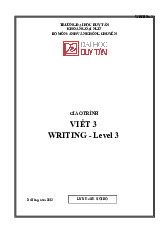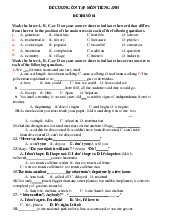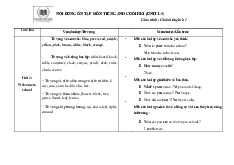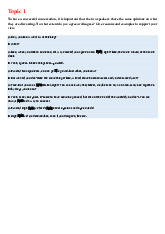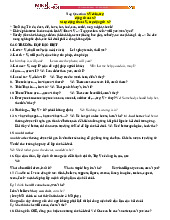











Preview text:
lOMoAR cPSD| 46836766 QUESTIONS FOR REVISION Lexicology
2. WHAT IS A MORPHEME? WHAT TYPES OF MORPHEMES ARE THERE?
- Morpheme may be de 昀椀 ned as the minimal meaningful language units.
Ex: bookish has 2 morphemes book and -ish unlucky
has 3 morphemes: un- + luck + -y
- There are 2 main types of morphemes: The root morpheme and the a 昀케 xa 琀椀 onal morpheme
+) The root morpheme is also called the lexial morpheme or simply the root. It is the primary
element of the word and conveys its essen 琀椀 al lexical meaning. In the examples “bookish; lOMoAR cPSD| 46836766
unlucky", we have the roots "book and luck". The root remains a 昀琀 er removing all the other
elements and cannot be analyzed any further.
+) The a 昀케 xa 琀椀 onal morpheme is further divided into the gramma 琀椀 cal morphome and
the deriva 琀椀 on and morpheme
- The gramma 琀椀 cal morpheme is also called in 昀氀 ec 琀椀 on or ending used to create di 昀
昀 erent jorms of the same word. It carries the gramma 琀椀 cal meaning only and is, therefore studied in grammar
Ex: -s in "books"; "-ed." in "asked, studied
- The deriva 琀椀 onal morpheme carries both lexical and gramma 琀椀 cal meaning. Because of
this dual nature, it can be called lexico - gramma 琀椀 cal morpheme.
Ex: pre-, un-; re-; -ness; -ful, -ly
- Morphemes can also categorized as free morphemes or bound morphemes. Free morphemes
can be asked as separate words, but bound morphemes cannot. lOMoAR cPSD| 46836766
3. How many types of words are there? What are they? Define them and give some examples for each type.
- There are 3 types of words: simple words, derived words and compound words.
+ A simple word is one that only consists of a root morpheme: “boy, girl, table"
+ A derived word is one that consists of a root and one or more deriva 琀椀 onal morphemes: Ex: teacher, student, amusing
+) A compound word is one that has at least two roots, with or without deriva 琀椀 onal morphemes.
Ex: blackboard, lady killer, whitewash
4. Can you list the types of word formation you’ve learned and provide some examples of each type? lOMoAR cPSD| 46836766
- There are 9 types of word forma 琀椀 on They are:
+ A 昀케 xa 琀椀 on: happiness, unlucky
+) Compounding: blackboard, lady killer.
+) Shortening: VNUA => Vietnam Na 琀椀 onal University of Agriculture
+) Conversion: a lecture and to lecture, a hand and to hand
+) Sound imita 琀椀 on: now, meow, buzz
+) Back deriva 琀椀 on: baby SA (from babysi 琀琀 er), to bag (from beggar )
+) Sound and stress interchange
Ex: food -> to jeed, long -> length, strong -> strength
+) Eponymy (word from name) lOMoAR cPSD| 46836766
Ex: braille (name of a raised wri 琀椀 ng system used by blind people) from the name of its French
inventors, Louis Braille Wolf (unit inventor, Tames Wa 琀琀 of power) from the Sco 琀 sh
+) Reduplica 琀椀 on
Ex: hawk-talkie, 琀椀 p-top, chit-chat, bye-bye
5. Give the definitions and examples of lexical meaning and grammatical meaning.
- Lexical meaning: the realiza 琀椀 on of concept or emo 琀椀 on.
When we hear or see the word "house”, for example, our concept is realized and the picture or
image of a house occurs to our mind. Therefore, this realiza 琀椀 on is called lexical meaning. Ex: book, man, women
- Gramma 琀椀 cal meaning: is what unites words with di 昀昀 erent lexical meanings. It is the
meaning recurrent in iden 琀椀 cal sets of di 昀昀 erent words. It devides words into groups lOMoAR cPSD| 46836766
with their own gramma 琀椀 cal features. For example, the gramma 琀椀 cal meaning of
house, book, man, and word, is that they are nouns in singular and common case. The
gramma 琀椀 cal meaning of “pre 琀琀 y, tall, dark, white, lexical, etc” is that they are adjec 琀椀 ves
6. What are the components of lexical meaning? Give one example for each component.
- The two components of lexical meaning are denota 琀椀 onal meaning and connota 琀椀 on
meaning +) The denota 琀椀 onal meaning (or denota 琀椀 on) indicates on denotes things, concepts, etc.
For example. "bird" denotes an animal that can 昀氀 y; "Father, dad, daddy" denotes the male parent.
+) The connota 琀椀 onal meaning ( or connota 琀椀 on ) show us how things, concepts, etc. are
indicated ( denoted ). It conveys the speaker's a 琀 tude, emo 琀椀 ons and so on “ Father, dad,
daddy" as men 琀椀 oned above, have the same denota 琀椀 onal meaning (a male parent) but di lOMoAR cPSD| 46836766
昀昀 erent connota 琀椀 onal meanings that is, they have di 昀昀 erent emo 琀椀 ve meanings
and stylis 琀椀 c references.
7. How many types of motivation of words are there? Can you provide the definitions and
examples of each type?
- There are 3 types of mo 琀椀 va 琀椀 on of words They are morphologic mo 琀椀 va 琀椀
on, phone 琀椀 c mo 琀椀 va 琀椀 on and seman 琀椀 c mo 琀椀 va 琀椀 on
+) Morphologic mo 琀椀 va 琀椀 on is the direct rela 琀椀 onship between the morphologic
structure of the word and its meaning (In other words it is the rela 琀椀 onship between morpheme of the word),
For example: "teacher" is a person who teaches.
+) Phone 琀椀 c mo 琀椀 va 琀椀 on is the rela 琀椀 onship between the meaning of the
word and its sound form or phone 琀椀 c structure, Ex: meow, buzz, his lOMoAR cPSD| 46836766
+) Seman 琀椀 c mo 琀椀 va 琀椀 on is the rela 琀椀 onship between direct and indirect meanings
Ex: foot (body part) and a foot of a mountain, head (body part) and the head of the Department
10. What is metaphor? Can you analyze the types of similarity that can be the sources of metaphors?
+ Metaphor is the transference of names based on the associa 琀椀 on of similarity. In other words,
metaphor is a hidden comparison.
+ here are various types of similari 琀椀 es on which metaphor is based:
- The similarity of shape: The head of a cabbage, the teeth of a saw
- The similarity of posi 琀椀 on: The foot of a mountain
- The similarity of func 琀椀 on: The key to the mystery, the door to the future
- The similarity of movement: to worm lOMoAR cPSD| 46836766
- The similarity of color: orange, violet
- The similarity of size: elephan 琀椀 ne, jumbo
- The similarity of behavior or characters: a fox, a snake in grass
The names of the parts of human body are a great source for metaphor. Eg: The leg of a table, the mouth of a cave
11. What is metonymy? What types of metonymy are there?
- Metonymy is the transference of names based on the associa 琀椀 on of con 琀椀 guity.
The name of one thing is changed for that of another to which it is related. Eg: The ke 琀琀 le is boiling
The cases/types of metonymy are/include:
- Names of containers used instead of the things contained. Eg: He drank twenty glasses. lOMoAR cPSD| 46836766
- Names of parts of the body used as symbols. Eg: She has a good ear for music.
- Proper names are used as common names. Eg: The boy ea 琀椀 ng a sandwich is wearing an expensive cardigan.
- Names of materials used instead of the things made of them. Eg: I've bought a new iron.
- Concrete things used instead of abstract things.
Eg: The White House decided to spend more money on cosmic explora 琀椀 on.
- A separate part used instead of a whole thing and vice versa.
Eg: I used to live without a roof over my head.
12. What is the definition of homonyms? How are they classified? lOMoAR cPSD| 46836766
- Homonyms are words iden 琀椀 cal in pronuncia 琀椀 on and/or spelling but di 昀昀 erent in meaning. Eg: fast - fast; here - hear
- There are 3 types of homonyms: homophones, homographs and full homonyms
+ Homophones are words iden 琀椀 cal in pronuncia 琀椀 on only Eg: piece-peace, buy-by
+ Homographs: are words iden 琀椀 cal in spelling only.
Eg: to tear/tear-tear/琀椀 ǝr/; wind/wind/ - to wind/wand, to lead /lid/ - lead/led/, read - read - read
+ Full (perfect) homonyms: are words iden 琀椀 cal in both pronuncia 琀椀 on and spelling :
Ex: to fast (go without food or some kinds of food)
fast (quickly) - fast (deeply, soundly) lOMoAR cPSD| 46836766
13. What are proverbs and idioms? How are they different?
- A proverb is a short saying expressing popular wisdom, a truth or a moral lesson in a concise
and imaginary way. English and Vietnamese have many similar proverbs:
He laughs best who laughs last.
Two heads are be 琀琀 er than one
- Idioms: are di 昀케 cult to de 昀椀 ne accurately. They are also set expressions, short sayings
usually characterized by the fact that their meaning cannot easily be deduced from their components.
Idioms are di 昀昀 erent from proverbs in that they are not "instruc 琀椀 ve, moral" in nature
